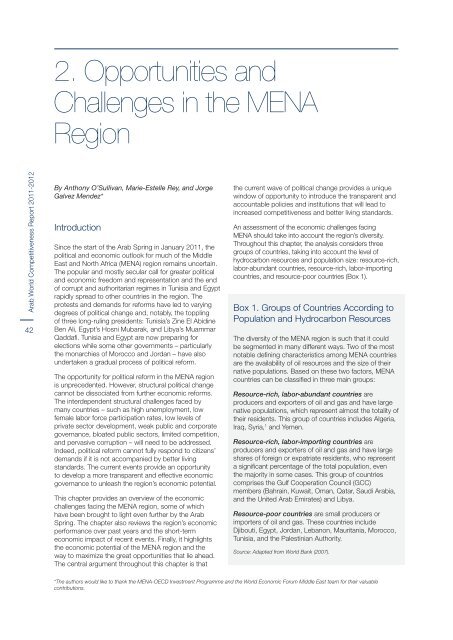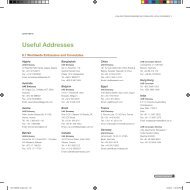Arab World Competitiveness Report 2011-2012 - World Economic ...
Arab World Competitiveness Report 2011-2012 - World Economic ...
Arab World Competitiveness Report 2011-2012 - World Economic ...
You also want an ePaper? Increase the reach of your titles
YUMPU automatically turns print PDFs into web optimized ePapers that Google loves.
2. Opportunities and<br />
Challenges in the MENA<br />
Region<br />
<strong>Arab</strong> <strong>World</strong> <strong>Competitiveness</strong> <strong>Report</strong> <strong>2011</strong>-<strong>2012</strong><br />
42<br />
By Anthony O’Sullivan, Marie-Estelle Rey, and Jorge<br />
Galvez Mendez*<br />
Introduction<br />
Since the start of the <strong>Arab</strong> Spring in January <strong>2011</strong>, the<br />
political and economic outlook for much of the Middle<br />
East and North Africa (MENA) region remains uncertain.<br />
The popular and mostly secular call for greater political<br />
and economic freedom and representation and the end<br />
of corrupt and authoritarian regimes in Tunisia and Egypt<br />
rapidly spread to other countries in the region. The<br />
protests and demands for reforms have led to varying<br />
degrees of political change and, notably, the toppling<br />
of three long-ruling presidents: Tunisia’s Zine El Abidine<br />
Ben Ali, Egypt’s Hosni Mubarak, and Libya’s Muammar<br />
Qaddafi. Tunisia and Egypt are now preparing for<br />
elections while some other governments – particularly<br />
the monarchies of Morocco and Jordan – have also<br />
undertaken a gradual process of political reform.<br />
The opportunity for political reform in the MENA region<br />
is unprecedented. However, structural political change<br />
cannot be dissociated from further economic reforms.<br />
The interdependent structural challenges faced by<br />
many countries – such as high unemployment, low<br />
female labor force participation rates, low levels of<br />
private sector development, weak public and corporate<br />
governance, bloated public sectors, limited competition,<br />
and pervasive corruption – will need to be addressed.<br />
Indeed, political reform cannot fully respond to citizens’<br />
demands if it is not accompanied by better living<br />
standards. The current events provide an opportunity<br />
to develop a more transparent and effective economic<br />
governance to unleash the region’s economic potential.<br />
This chapter provides an overview of the economic<br />
challenges facing the MENA region, some of which<br />
have been brought to light even further by the <strong>Arab</strong><br />
Spring. The chapter also reviews the region’s economic<br />
performance over past years and the short-term<br />
economic impact of recent events. Finally, it highlights<br />
the economic potential of the MENA region and the<br />
way to maximize the great opportunities that lie ahead.<br />
The central argument throughout this chapter is that<br />
the current wave of political change provides a unique<br />
window of opportunity to introduce the transparent and<br />
accountable policies and institutions that will lead to<br />
increased competitiveness and better living standards.<br />
An assessment of the economic challenges facing<br />
MENA should take into account the region’s diversity.<br />
Throughout this chapter, the analysis considers three<br />
groups of countries, taking into account the level of<br />
hydrocarbon resources and population size: resource-rich,<br />
labor-abundant countries, resource-rich, labor-importing<br />
countries, and resource-poor countries (Box 1).<br />
Box 1. Groups of Countries According to<br />
Population and Hydrocarbon Resources<br />
The diversity of the MENA region is such that it could<br />
be segmented in many different ways. Two of the most<br />
notable defining characteristics among MENA countries<br />
are the availability of oil resources and the size of their<br />
native populations. Based on these two factors, MENA<br />
countries can be classified in three main groups:<br />
Resource-rich, labor-abundant countries are<br />
producers and exporters of oil and gas and have large<br />
native populations, which represent almost the totality of<br />
their residents. This group of countries includes Algeria,<br />
Iraq, Syria, 1 and Yemen.<br />
Resource-rich, labor-importing countries are<br />
producers and exporters of oil and gas and have large<br />
shares of foreign or expatriate residents, who represent<br />
a significant percentage of the total population, even<br />
the majority in some cases. This group of countries<br />
comprises the Gulf Cooperation Council (GCC)<br />
members (Bahrain, Kuwait, Oman, Qatar, Saudi <strong>Arab</strong>ia,<br />
and the United <strong>Arab</strong> Emirates) and Libya.<br />
Resource-poor countries are small producers or<br />
importers of oil and gas. These countries include<br />
Djibouti, Egypt, Jordan, Lebanon, Mauritania, Morocco,<br />
Tunisia, and the Palestinian Authority.<br />
Source: Adapted from <strong>World</strong> Bank (2007).<br />
*The authors would like to thank the MENA-OECD Investment Programme and the <strong>World</strong> <strong>Economic</strong> Forum Middle East team for their valuable<br />
contributions.





